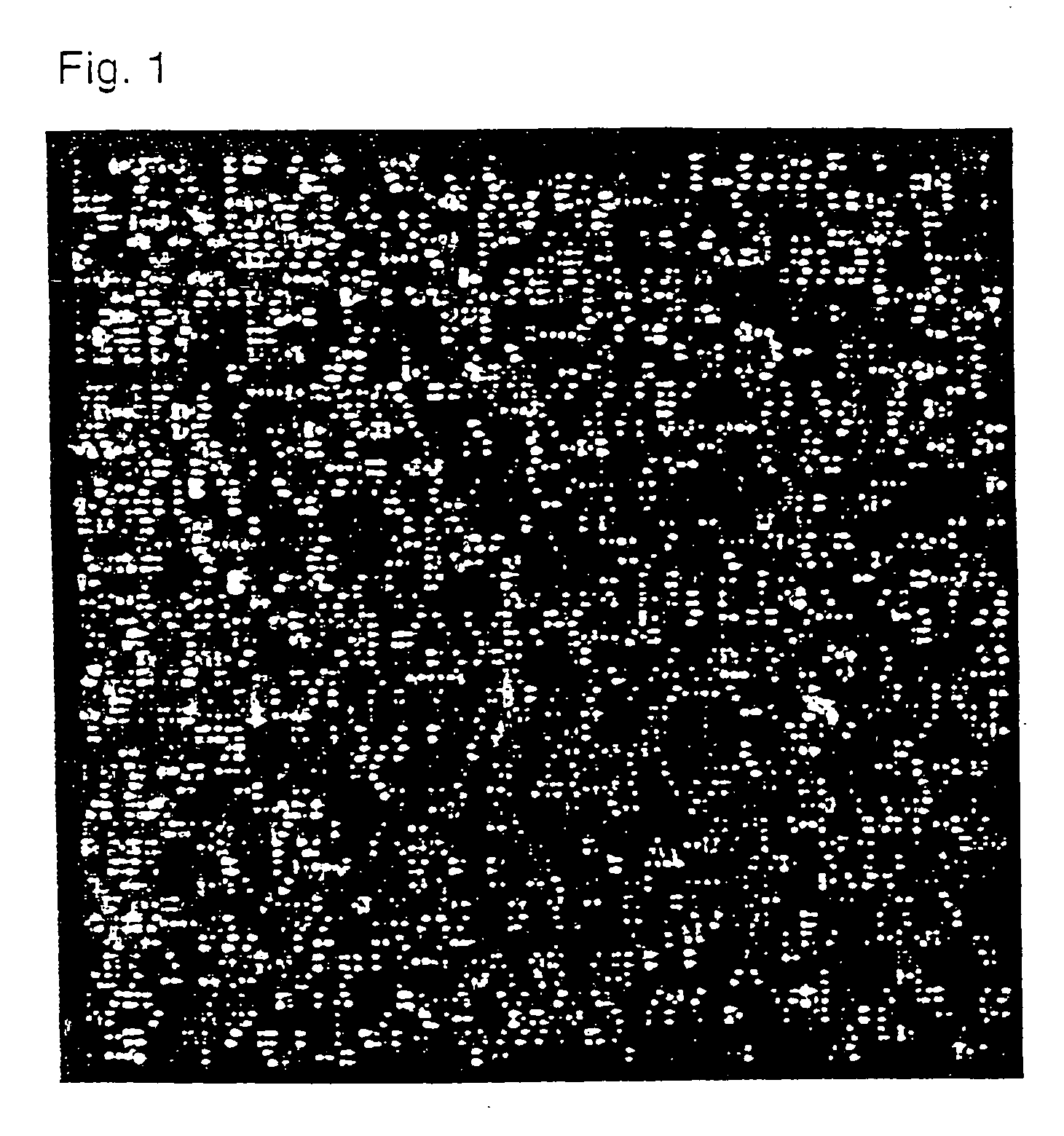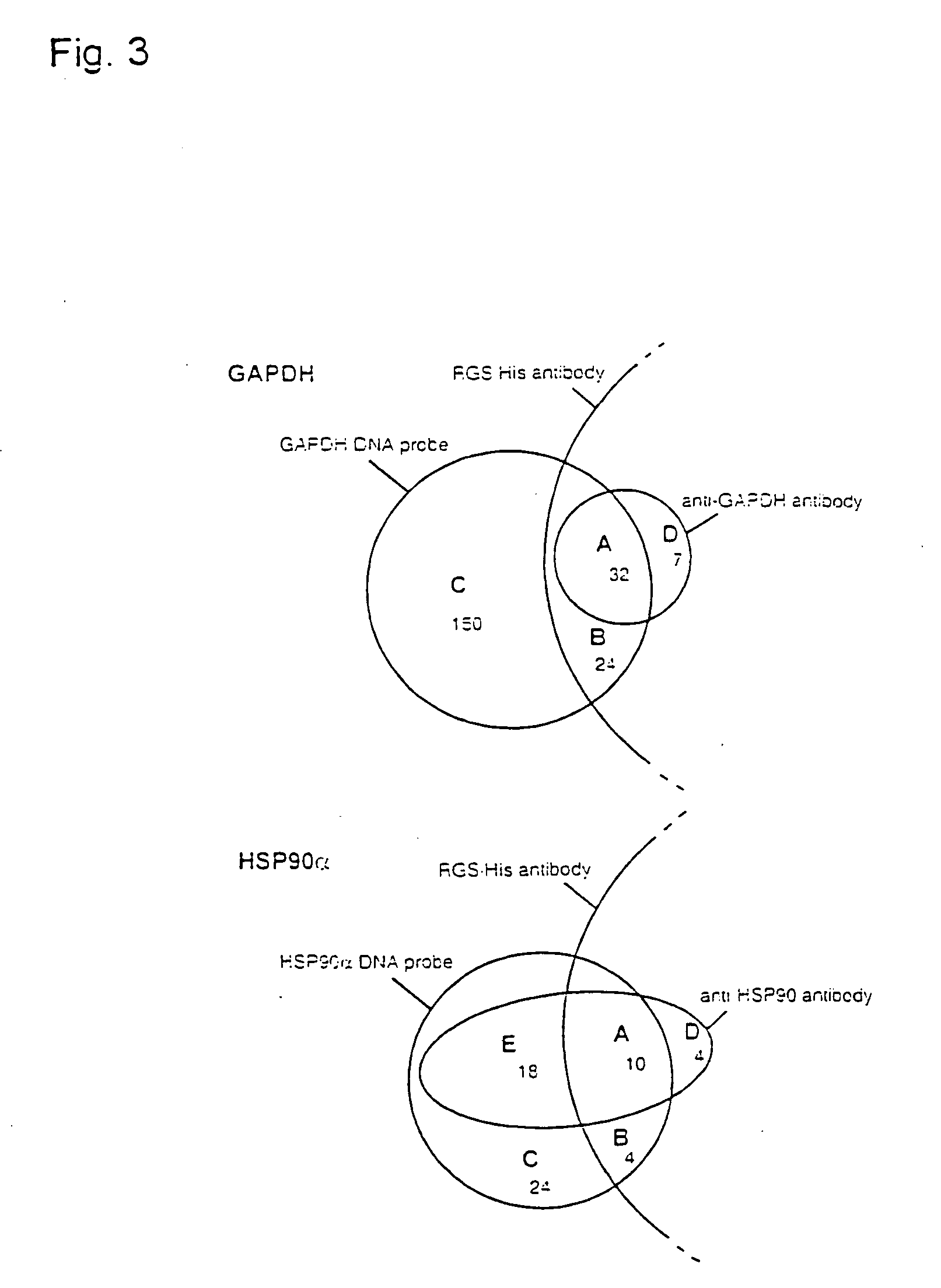Novel method for the identification of clones conferring a desired biological property from an expression library
- Summary
- Abstract
- Description
- Claims
- Application Information
AI Technical Summary
Benefits of technology
Problems solved by technology
Method used
Image
Examples
example 1
Construction of an Arrayed Human cDNA Expression Library
[0096] A directionally cloned human fetal brain cDNA library (hE×1) was constructed in pQE 3ONST, a vector for IPTG-inducible expression of His6-tagged fusion proteins. pQE30-NST was constructed from pQE-30 (Qiagen), a pBR322-based expression vector that carries a phage T5 promoter and two lac operators for IPTG-inducible recombinant protein expression as follows; in the first step, pQE-30N was generated by inserting a synthetic oligonucleotide carrying a BgIII and a NotI site into the unique PstI site of pQE-30. In subsequent steps, an SP6 promoter oligonucleotide carrying an SP6 promoter was inserted between the BamHI and the Sall site of pQE-30N, followed by insertion of a second oligonucleotide carrying a T7 promoter between the HindIII and the NotI site. The resulting vector, pQE-30NST, can be used for cloning of cDNAs with Sall and NotI overhangs. The insert can be transcribed in vitro in sense direction using SP6 RNA po...
example 2
Protein Expression Screening on High-density Filters
[0102] High-density protein filters of the hE×1 library were screened with the monoclonal RGS•His antibody recognizing the N-terminal sequence RGSH6 of recombinant fusion proteins overexpressed from the pQE-30NST vector. (FIG. 1). Approximately 20% of the clones were positive (signals of intensities 1, 2 or 3), classified one to three. These clones were considered putative protein expression clones (FIG. 1). The hE×1 cDNA library was prepared from human fetal brain tissues by oligo (dT) priming (Gubler et al., Gene 25 (1983), 263) using a Superscript Plasmid System kit (Life Technologies). cDNA was size-fractionated by gel filtration and individual fractions were ligated between the SaII and NotI sites of the expression vector pQE-30NST. E. coli SCS1 (Stratagene) carrying the helper plasmid pSE111 was used as the host strain. After transformation by electroporation, the library was plated onto square agar plates (Nunc Bio Assay Di...
example3
Identification of Genes and Proteins on Corresponding Filter Sets
[0103] GAPDH and HSP90a were chosen as example proteins, with open reading frames of 1,008 bp and 35,922 Dalton for GAPDH (Swiss-Prot P04406) and 2,199 bp and 84,542 Dalton for HSP90a (Swiss-Prot P07900).
[0104] A set of three high-density DNA filters (80,640 clones) of the hE×1 library was screened with gene-specific cDNA probes. High-density filters were prepared by robot spotting, as described (Maier et al., Drug Discovery Today 2 (1994), 315-324; Lehrach etal., Interdisciplinary Science Reviews 22 (1997), 37-44). Bacterial colonies were gridded onto Nylon membrane filters (Hybond N+, Amersham) for DNA analysis and on polyvinylidene difluoride (PVDF) membrane filters (Hybond-PVDF, Amersham) for protein analysis (filter format 222 mm×222 mm). Clones were spotted at a density of 27,648 clones per filter in a duplicate pattern, surrounding ink guide dots. High-density filters were placed onto square 2×YT agar plates (...
PUM
| Property | Measurement | Unit |
|---|---|---|
| Dimension | aaaaa | aaaaa |
| Biological properties | aaaaa | aaaaa |
| Interaction | aaaaa | aaaaa |
Abstract
Description
Claims
Application Information
 Login to View More
Login to View More - R&D
- Intellectual Property
- Life Sciences
- Materials
- Tech Scout
- Unparalleled Data Quality
- Higher Quality Content
- 60% Fewer Hallucinations
Browse by: Latest US Patents, China's latest patents, Technical Efficacy Thesaurus, Application Domain, Technology Topic, Popular Technical Reports.
© 2025 PatSnap. All rights reserved.Legal|Privacy policy|Modern Slavery Act Transparency Statement|Sitemap|About US| Contact US: help@patsnap.com



